ESAB Plasma Cutting Power Supply CE CutMaster™ 50 CE CutMaster™ 75 CE CutMaster™ 100 Manuel utilisateur
- Catégorie
- Système de soudage
- Taper
- Manuel utilisateur

Plasma Cutting
Power Supply
CE CutMaster
TM
50
CE CutMaster
TM
75
CE CutMaster
TM
100
A-02766
April 21, 2003 Manual No. 0-2844
Operating Manual

WARNINGS
Read and understand this entire Manual and your employer’s safety practices before installing, oper-
ating, or servicing the equipment.
While the information contained in this Manual represents the Manufacturer's best judgement, the
Manufacturer assumes no liability for its use.
Plasma Cutting Power Supply
CE CutMaster™ 50
CE CutMaster™ 75
CE CutMaster™ 100
Operating Manual Number 0-2844
Published by:
Thermal Dynamics Corporation
82 Benning Street
West Lebanon, New Hampshire, USA 03784
(603) 298-5711
Copyright 2001 by
Thermal Dynamics Corporation
All rights reserved.
Reproduction of this work, in whole or in part, without written per-
mission of the publisher is prohibited.
The publisher does not assume and hereby disclaims any liability to
any party for any loss or damage caused by any error or omission in
this Manual, whether such error results from negligence, accident, or
any other cause.
Printed in the United States of America
Publication Date: April 21, 2003
Record the following information for Warranty purposes:
Where Purchased:_________________________________________
Purchase Date:____________________________________________
Model Number:____________________________________________
Power Supply Serial #:_____________________________________
Torch Serial #:_____________________________________________

TABLE OF CONTENTS
SECTION 1:
GENERAL INFORMATION ............................................................................................... 1-1
1.01 Notes, Cautions and Warnings ..................................................................... 1-1
1.02 Important Safety Precautions ....................................................................... 1-1
1.03 Publications.................................................................................................. 1-2
1.04 Note, Attention et Avertissement .................................................................. 1-3
1.05 Precautions De Securite Importantes........................................................... 1-3
1.06 Documents De Reference............................................................................ 1-5
1.07 Declaration of Conformity............................................................................. 1-7
1.08 Statement of Warranty.................................................................................. 1-8
SECTION 2:
INTRODUCTION .............................................................................................................. 2-1
2.01 Scope of Manual .......................................................................................... 2-1
2.02 General Description ..................................................................................... 2-1
2.03 Specifications/Design Features .................................................................... 2-1
2.04 Power Supply Options and Accessories....................................................... 2-2
SECTION 3:
INSTALLATION PROCEDURES ....................................................................................... 3-1
3.01 Introduction .................................................................................................. 3-1
3.02 Site Selection ............................................................................................... 3-1
3.03 Unpacking .................................................................................................... 3-1
3.04 Lifting Options .............................................................................................. 3-1
3.05 Primary Input Power Connections ................................................................ 3-2
3.06 Gas Connections......................................................................................... 3-2
3.07 Torch Connections ....................................................................................... 3-4
3.08 Ground Connections For Mechanized Applications ...................................... 3-6
SECTION 4:
OPERATION ..................................................................................................................... 4-1
4.01 Introduction .................................................................................................. 4-1
4.02 Product Features.......................................................................................... 4-1
4.03 Preparations For Operating .......................................................................... 4-2
4.04 Sequence of Operation ................................................................................ 4-3
SECTION 5:
CUSTOMER/OPERATOR SERVICE................................................................................. 5-1
5.01 Introduction .................................................................................................. 5-1
5.02 General Maintenance ................................................................................... 5-1
5.03 Common Faults............................................................................................ 5-2
5.04 Basic Troubleshooting Guide ........................................................................ 5-3
5.05 Power Supply Basic Parts Replacement ...................................................... 5-5

TABLE OF CONTENTS (continued)
SECTION 6:
PARTS LISTS.................................................................................................................... 6-1
6.01 Introduction .................................................................................................. 6-1
6.02 Ordering Information .................................................................................... 6-1
6.03 Power Supply Replacement ......................................................................... 6-2
6.04 Basic Replacement Parts ............................................................................. 6-2
6.05 Options and Accessories ............................................................................. 6-2
APPENDIX 1: INPUT WIRING REQUIREMENTS ....................................................................A-1
APPENDIX 2: SEQUENCE OF OPERATION (BLOCK DIAGRAM) ..........................................A-2
APPENDIX 3: TORCH CONTROL CABLE WIRING DIAGRAM................................................A-3
APPENDIX 4: ROUTINE MAINTENANCE SCHEDULE...........................................................A-4
APPENDIX 5: SYSTEM SCHEMATIC (CE CutMaster 50) ........................................................A-6
APPENDIX 6: SYSTEM SCHEMATIC (CE CutMaster 75) ........................................................A-8
APPENDIX 7: SYSTEM SCHEMATIC (CE CutMaster 100) ....................................................A-10

Date: November 15, 2001 1-1 GENERAL INFORMATION
SECTION 1:
GENERAL INFORMATION
1.01 Notes, Cautions and Warnings
Throughout this manual, notes, cautions, and warnings
are used to highlight important information. These high-
lights are categorized as follows:
NOTE
An operation, procedure, or background informa-
tion which requires additional emphasis or is help-
ful in efficient operation of the system.
CAUTION
A procedure which, if not properly followed, may
cause damage to the equipment.
WARNING
A procedure which, if not properly followed, may
cause injury to the operator or others in the oper-
ating area.
1.02 Important Safety Precautions
WARNINGS
OPERATION AND MAINTENANCE OF
PLASMA ARC EQUIPMENT CAN BE DAN-
GEROUS AND HAZARDOUS TO YOUR
HEALTH.
Plasma arc cutting produces intense electric and
magnetic emissions that may interfere with the
proper function of cardiac pacemakers, hearing
aids, or other electronic health equipment. Per-
sons who work near plasma arc cutting applica-
tions should consult their medical health profes-
sional and the manufacturer of the health
equipment to determine whether a hazard exists.
To prevent possible injury, read, understand and
follow all warnings, safety precautions and in-
structions before using the equipment. Call 1-603-
298-5711 or your local distributor if you have any
questions.
GASES AND FUMES
Gases and fumes produced during the plasma cutting
process can be dangerous and hazardous to your health.
• Keep all fumes and gases from the breathing area.
Keep your head out of the welding fume plume.
• Use an air-supplied respirator if ventilation is not
adequate to remove all fumes and gases.
• The kinds of fumes and gases from the plasma arc
depend on the kind of metal being used, coatings
on the metal, and the different processes. You must
be very careful when cutting or welding any met-
als which may contain one or more of the follow-
ing:
Antimony Chromium Mercury
Arsenic Cobalt Nickel
Barium Copper Selenium
Beryllium Lead Silver
Cadmium Manganese Vanadium
• Always read the Material Safety Data Sheets
(MSDS) that should be supplied with the material
you are using. These MSDSs will give you the in-
formation regarding the kind and amount of fumes
and gases that may be dangerous to your health.
• For information on how to test for fumes and gases
in your workplace, refer to item 1 in Subsection 1.03,
Publications in this manual.
• Use special equipment, such as water or down draft
cutting tables, to capture fumes and gases.
• Do not use the plasma torch in an area where com-
bustible or explosive gases or materials are located.
• Phosgene, a toxic gas, is generated from the vapors
of chlorinated solvents and cleansers. Remove all
sources of these vapors.
• This product, when used for welding or cutting,
produces fumes or gases which contain chemicals
known to the State of California to cause birth de-
fects and, in some cases, cancer. (California Health
& Safety Code Sec. 25249.5 et seq.)
ELECTRIC SHOCK
Electric Shock can injure or kill. The plasma arc process
uses and produces high voltage electrical energy. This
electric energy can cause severe or fatal shock to the op-
erator or others in the workplace.
• Never touch any parts that are electrically “live”
or “hot.”

GENERAL INFORMATION 1-2 Date: November 15, 2001
• Wear dry gloves and clothing. Insulate yourself
from the work piece or other parts of the welding
circuit.
• Repair or replace all worn or damaged parts.
• Extra care must be taken when the workplace is
moist or damp.
• Install and maintain equipment according to NEC
code, refer to item 9 in Subsection 1.03, Publica-
tions.
• Disconnect power source before performing any
service or repairs.
• Read and follow all the instructions in the Operat-
ing Manual.
FIRE AND EXPLOSION
Fire and explosion can be caused by hot slag, sparks, or
the plasma arc.
• Be sure there is no combustible or flammable ma-
terial in the workplace. Any material that cannot
be removed must be protected.
• Ventilate all flammable or explosive vapors from
the workplace.
• Do not cut or weld on containers that may have
held combustibles.
• Provide a fire watch when working in an area where
fire hazards may exist.
• Hydrogen gas may be formed and trapped under
aluminum workpieces when they are cut under-
water or while using a water table. DO NOT cut
aluminum alloys underwater or on a water table
unless the hydrogen gas can be eliminated or dis-
sipated. Trapped hydrogen gas that is ignited will
cause an explosion.
NOISE
Noise can cause permanent hearing loss. Plasma arc pro-
cesses can cause noise levels to exceed safe limits. You
must protect your ears from loud noise to prevent per-
manent loss of hearing.
• To protect your hearing from loud noise, wear pro-
tective ear plugs and/or ear muffs. Protect others
in the workplace.
• Noise levels should be measured to be sure the deci-
bels (sound) do not exceed safe levels.
• For information on how to test for noise, see item 1
in Subsection 1.03, Publications, in this manual.
PLASMA ARC RAYS
Plasma Arc Rays can injure your eyes and burn your skin.
The plasma arc process produces very bright ultra violet
and infra red light. These arc rays will damage your
eyes and burn your skin if you are not properly protected.
• To protect your eyes, always wear a welding hel-
met or shield. Also always wear safety glasses with
side shields, goggles or other protective eye wear.
• Wear welding gloves and suitable clothing to pro-
tect your skin from the arc rays and sparks.
• Keep helmet and safety glasses in good condition.
Replace lenses when cracked, chipped or dirty.
• Protect others in the work area from the arc rays.
Use protective booths, screens or shields.
• Use the shade of lens as suggested in the following
per ANSI/ASC Z49.1:
Minimum Protective Suggested
Arc Current Shade No. Shade No.
Less Than 300* 8 9
300 - 400* 9 12
400 - 800* 10 14
* These values apply where the actual arc is clearly
seen. Experience has shown that lighter filters
may be used when the arc is hidden by the work-
piece.
1.03 Publications
Refer to the following standards or their latest revisions
for more information:
1. OSHA, SAFETY AND HEALTH STANDARDS, 29CFR
1910, obtainable from the Superintendent of Docu-
ments, U.S. Government Printing Office, Washington,
D.C. 20402
2. ANSI Standard Z49.1, SAFETY IN WELDING AND
CUTTING, obtainable from the American Welding So-
ciety, 550 N.W. LeJeune Rd, Miami, FL 33126
3. NIOSH, SAFETY AND HEALTH IN ARC WELDING
AND GAS WELDING AND CUTTING, obtainable
from the Superintendent of Documents, U.S. Govern-
ment Printing Office, Washington, D.C. 20402
4. ANSI Standard Z87.1, SAFE PRACTICES FOR OCCU-
PATION AND EDUCATIONAL EYE AND FACE PRO-
TECTION, obtainable from American National Stan-
dards Institute, 1430 Broadway, New York, NY 10018
5. ANSI Standard Z41.1, STANDARD FOR MEN’S
SAFETY-TOE FOOTWEAR, obtainable from the Ameri-
can National Standards Institute, 1430 Broadway, New
York, NY 10018

Date: November 15, 2001 1-3 GENERAL INFORMATION
6. ANSI Standard Z49.2, FIRE PREVENTION IN THE USE
OF CUTTING AND WELDING PROCESSES, obtain-
able from American National Standards Institute, 1430
Broadway, New York, NY 10018
7. AWS Standard A6.0, WELDING AND CUTTING CON-
TAINERS WHICH HAVE HELD COMBUSTIBLES, ob-
tainable from American Welding Society, 550 N.W.
LeJeune Rd, Miami, FL 33126
8. NFPA Standard 51, OXYGEN-FUEL GAS SYSTEMS
FOR WELDING, CUTTING AND ALLIED PRO-
CESSES, obtainable from the National Fire Protection
Association, Batterymarch Park, Quincy, MA 02269
9. NFPA Standard 70, NATIONAL ELECTRICAL CODE,
obtainable from the National Fire Protection Associa-
tion, Batterymarch Park, Quincy, MA 02269
10. NFPA Standard 51B, CUTTING AND WELDING PRO-
CESSES, obtainable from the National Fire Protection
Association, Batterymarch Park, Quincy, MA 02269
11. CGA Pamphlet P-1, SAFE HANDLING OF COM-
PRESSED GASES IN CYLINDERS, obtainable from the
Compressed Gas Association, 1235 Jefferson Davis
Highway, Suite 501, Arlington, VA 22202
12. CSA Standard W117.2, CODE FOR SAFETY IN WELD-
ING AND CUTTING, obtainable from the Canadian
Standards Association, Standards Sales, 178 Rexdale
Boulevard, Rexdale, Ontario, Canada M9W 1R3
13. NWSA booklet, WELDING SAFETY BIBLIOGRAPHY
obtainable from the National Welding Supply Associa-
tion, 1900 Arch Street, Philadelphia, PA 19103
14. American Welding Society Standard AWSF4.1, RECOM-
MENDED SAFE PRACTICES FOR THE PREPARA-
TION FOR WELDING AND CUTTING OF CONTAIN-
ERS AND PIPING THAT HAVE HELD HAZARDOUS
SUBSTANCES, obtainable from the American Welding
Society, 550 N.W. LeJeune Rd, Miami, FL 33126
15. ANSI Standard Z88.2, PRACTICE FOR RESPIRATORY
PROTECTION, obtainable from American National
Standards Institute, 1430 Broadway, New York, NY
10018
1.04 Note, Attention et
Avertissement
Dans ce manuel, les mots “note,” “attention,” et
“avertissement” sont utilisés pour mettre en relief des
informations à caractère important. Ces mises en relief
sont classifiées comme suit :
NOTE
Toute opération, procédure ou renseignement
général sur lequel il importe d’insister davantage
ou qui contribue à l’efficacité de fonctionnement
du système.
ATTENTION
Toute procédure pouvant résulter
l’endommagement du matériel en cas de non-
respect de la procédure en question.
AVERTISSEMENT
Toute procédure pouvant provoquer des blessures
de l’opérateur ou des autres personnes se trouvant
dans la zone de travail en cas de non-respect de la
procédure en question.
1.05 Precautions De Securite
Importantes
AVERTISSEMENTS
L’OPÉRATION ET LA MAINTENANCE DU
MATÉRIEL DE SOUDAGE À L’ARC AU JET
DE PLASMA PEUVENT PRÉSENTER DES
RISQUES ET DES DANGERS DE SANTÉ.
Coupant à l’arc au jet de plasma produit de l’énergie
électrique haute tension et des émissions
magnétique qui peuvent interférer la fonction
propre d’un “pacemaker” cardiaque, les appareils
auditif, ou autre matériel de santé electronique.
Ceux qui travail près d’une application à l’arc au
jet de plasma devrait consulter leur membre
professionel de médication et le manufacturier de
matériel de santé pour déterminer s’il existe des
risques de santé.
Il faut communiquer aux opérateurs et au person-
nel TOUS les dangers possibles. Afin d’éviter les
blessures possibles, lisez, comprenez et suivez tous
les avertissements, toutes les précautions de sécurité
et toutes les consignes avant d’utiliser le matériel.
Composez le + 603-298-5711 ou votre distributeur
local si vous avez des questions.
FUMÉE et GAZ
La fumée et les gaz produits par le procédé de jet de
plasma peuvent présenter des risques et des dangers de
santé.

GENERAL INFORMATION 1-4 Date: November 15, 2001
• Eloignez toute fumée et gaz de votre zone de respira-
tion. Gardez votre tête hors de la plume de fumée
provenant du chalumeau.
• Utilisez un appareil respiratoire à alimentation en air
si l’aération fournie ne permet pas d’éliminer la fumée
et les gaz.
• Les sortes de gaz et de fumée provenant de l’arc de
plasma dépendent du genre de métal utilisé, des
revêtements se trouvant sur le métal et des différents
procédés. Vous devez prendre soin lorsque vous
coupez ou soudez tout métal pouvant contenir un ou
plusieurs des éléments suivants:
antimoine cadmium mercure
argent chrome nickel
arsenic cobalt plomb
baryum cuivre sélénium
béryllium manganèse vanadium
• Lisez toujours les fiches de données sur la sécurité
des matières (sigle américain “MSDS”); celles-ci
devraient être fournies avec le matériel que vous
utilisez. Les MSDS contiennent des renseignements
quant à la quantité et la nature de la fumée et des gaz
pouvant poser des dangers de santé.
• Pour des informations sur la manière de tester la
fumée et les gaz de votre lieu de travail, consultez
l’article 1 et les documents cités à la page 5.
• Utilisez un équipement spécial tel que des tables de
coupe à débit d’eau ou à courant descendant pour
capter la fumée et les gaz.
• N’utilisez pas le chalumeau au jet de plasma dans une
zone où se trouvent des matières ou des gaz combus-
tibles ou explosifs.
• Le phosgène, un gaz toxique, est généré par la fumée
provenant des solvants et des produits de nettoyage
chlorés. Eliminez toute source de telle fumée.
• Ce produit, dans le procéder de soudage et de coupe,
produit de la fumée ou des gaz pouvant contenir des
éléments reconnu dans L’état de la Californie, qui
peuvent causer des défauts de naissance et le cancer.
(La sécurité de santé en Californie et la code sécurité
Sec. 25249.5 et seq.)
CHOC ELECTRIQUE
Les chocs électriques peuvent blesser ou même tuer. Le
procédé au jet de plasma requiert et produit de l’énergie
électrique haute tension. Cette énergie électrique peut
produire des chocs graves, voire mortels, pour l’opérateur
et les autres personnes sur le lieu de travail.
• Ne touchez jamais une pièce “sous tension” ou “vive”;
portez des gants et des vêtements secs. Isolez-vous
de la pièce de travail ou des autres parties du circuit
de soudage.
• Réparez ou remplacez toute pièce usée ou
endommagée.
• Prenez des soins particuliers lorsque la zone de tra-
vail est humide ou moite.
• Montez et maintenez le matériel conformément au
Code électrique national des Etats-Unis. (Voir la page
5, article 9.)
• Débranchez l’alimentation électrique avant tout tra-
vail d’entretien ou de réparation.
• Lisez et respectez toutes les consignes du Manuel de
consignes.
INCENDIE ET EXPLOSION
Les incendies et les explosions peuvent résulter des scories
chaudes, des étincelles ou de l’arc de plasma. Le procédé
à l’arc de plasma produit du métal, des étincelles, des
scories chaudes pouvant mettre le feu aux matières com-
bustibles ou provoquer l’explosion de fumées
inflammables.
• Soyez certain qu’aucune matière combustible ou in-
flammable ne se trouve sur le lieu de travail. Protégez
toute telle matière qu’il est impossible de retirer de la
zone de travail.
• Procurez une bonne aération de toutes les fumées
inflammables ou explosives.
• Ne coupez pas et ne soudez pas les conteneurs ayant
pu renfermer des matières combustibles.
• Prévoyez une veille d’incendie lors de tout travail dans
une zone présentant des dangers d’incendie.
• Le gas hydrogène peut se former ou s’accumuler sous
les pièces de travail en aluminium lorsqu’elles sont
coupées sous l’eau ou sur une table d’eau. NE PAS
couper les alliages en aluminium sous l’eau ou sur
une table d’eau à moins que le gas hydrogène peut
s’échapper ou se dissiper. Le gas hydrogène accumulé
explosera si enflammé.
RAYONS D’ARC DE PLASMA
Les rayons provenant de l’arc de plasma peuvent blesser
vos yeux et brûler votre peau. Le procédé à l’arc de
plasma produit une lumière infra-rouge et des rayons

Date: November 15, 2001 1-5 GENERAL INFORMATION
ultra-violets très forts. Ces rayons d’arc nuiront à vos
yeux et brûleront votre peau si vous ne vous protégez
pas correctement.
• Pour protéger vos yeux, portez toujours un casque ou
un écran de soudeur. Portez toujours des lunettes de
sécurité munies de parois latérales ou des lunettes de
protection ou une autre sorte de protection oculaire.
• Portez des gants de soudeur et un vêtement protecteur
approprié pour protéger votre peau contre les
étincelles et les rayons de l’arc.
• Maintenez votre casque et vos lunettes de protection
en bon état. Remplacez toute lentille sale ou
comportant fissure ou rognure.
• Protégez les autres personnes se trouvant sur la zone
de travail contre les rayons de l’arc en fournissant des
cabines ou des écrans de protection.
• Utilisez la nuance de lentille qui est suggèrée dans le
recommendation qui suivent ANSI/ASC Z49.1:
Nuance Minimum Nuance Suggerée
Courant Arc Protective Numéro Numéro
Moins de 300* 8 9
300 - 400* 9 12
400 - 800* 10 14
* Ces valeurs s’appliquent ou l’arc actuel est observé
clairement. L’experience a démontrer que les filtres
moins foncés peuvent être utilisés quand l’arc est
caché par moiceau de travail.
BRUIT
Le bruit peut provoquer une perte permanente de l’ouïe.
Les procédés de soudage à l’arc de plasma peuvent
provoquer des niveaux sonores supérieurs aux limites
normalement acceptables. Vous dú4ez vous protéger les
oreilles contre les bruits forts afin d’éviter une perte
permanente de l’ouïe.
• Pour protéger votre ouïe contre les bruits forts, portez
des tampons protecteurs et/ou des protections
auriculaires. Protégez également les autres personnes
se trouvant sur le lieu de travail.
• Il faut mesurer les niveaux sonores afin d’assurer que
les décibels (le bruit) ne dépassent pas les niveaux
sûrs.
• Pour des renseignements sur la manière de tester le
bruit, consultez l’article 1, page 5.
1.06 Documents De Reference
Consultez les normes suivantes ou les révisions les plus
récentes ayant été faites à celles-ci pour de plus amples
renseignements :
1. OSHA, NORMES DE SÉCURITÉ DU TRAVAIL ET DE
PROTECTION DE LA SANTÉ, 29CFR 1910,
disponible auprès du Superintendent of Documents,
U.S. Government Printing Office, Washington, D.C.
20402
2. Norme ANSI Z49.1, LA SÉCURITÉ DES
OPÉRATIONS DE COUPE ET DE SOUDAGE,
disponible auprès de la Société Américaine de
Soudage (American Welding Society), 550 N.W.
LeJeune Rd., Miami, FL 33126
3. NIOSH, LA SÉCURITÉ ET LA SANTÉ LORS DES
OPÉRATIONS DE COUPE ET DE SOUDAGE À
L’ARC ET AU GAZ, disponible auprès du Superin-
tendent of Documents, U.S. Government Printing
Office, Washington, D.C. 20402
4. Norme ANSI Z87.1, PRATIQUES SURES POUR LA
PROTECTION DES YEUX ET DU VISAGE AU TRA-
VAIL ET DANS LES ECOLES, disponible de l’Institut
Américain des Normes Nationales (American Na-
tional Standards Institute), 1430 Broadway, New York,
NY 10018
5. Norme ANSI Z41.1, NORMES POUR LES
CHAUSSURES PROTECTRICES, disponible auprès
de l’American National Standards Institute, 1430
Broadway, New York, NY 10018
6. Norme ANSI Z49.2, PRÉVENTION DES INCENDIES
LORS DE L’EMPLOI DE PROCÉDÉS DE COUPE ET
DE SOUDAGE, disponible auprès de l’American Na-
tional Standards Institute, 1430 Broadway, New York,
NY 10018
7. Norme A6.0 de l’Association Américaine du Soudage
(AWS), LE SOUDAGE ET LA COUPE DE
CONTENEURS AYANT RENFERMÉ DES PRODUITS
COMBUSTIBLES, disponible auprès de la American
Welding Society, 550 N.W. LeJeune Rd., Miami, FL
33126
8. Norme 51 de l’Association Américaine pour la Pro-
tection contre les Incendies (NFPA), LES SYSTEMES
À GAZ AVEC ALIMENTATION EN OXYGENE
POUR LE SOUDAGE, LA COUPE ET LES
PROCÉDÉS ASSOCIÉS, disponible auprès de la Na-
tional Fire Protection Association, Batterymarch Park,
Quincy, MA 02269

GENERAL INFORMATION 1-6 Date: November 15, 2001
9. Norme 70 de la NFPA, CODE ELECTRIQUE NA-
TIONAL, disponible auprès de la National Fire Pro-
tection Association, Batterymarch Park, Quincy, MA
02269
10.Norme 51B de la NFPA, LES PROCÉDÉS DE
COUPE ET DE SOUDAGE, disponible auprès de la
National Fire Protection Association, Batterymarch
Park, Quincy, MA 02269
11. Brochure GCA P-1, LA MANIPULATION SANS
RISQUE DES GAZ COMPRIMÉS EN CYLINDRES,
disponible auprès de l’Association des Gaz
Comprimés (Compressed Gas Association), 1235
Jefferson Davis Highway, Suite 501, Arlington, VA
22202
12. Norme CSA W117.2, CODE DE SÉCURITÉ POUR
LE SOUDAGE ET LA COUPE, disponible auprès
de l’Association des Normes Canadiennes, Stan-
dards Sales, 178 Rexdale Boulevard, Rexdale,
Ontario, Canada, M9W 1R3
13. Livret NWSA, BIBLIOGRAPHIE SUR LA
SÉCURITÉ DU SOUDAGE, disponible auprès de
l’Association Nationale de Fournitures de Soudage
(National Welding Supply Association), 1900 Arch
Street, Philadelphia, PA 19103
14. Norme AWSF4.1 de l’Association Américaine de
Soudage, RECOMMANDATIONS DE PRATIQUES
SURES POUR LA PRÉPARATION À LA COUPE ET
AU SOUDAGE DE CONTENEURS ET TUYAUX
AYANT RENFERMÉ DES PRODUITS
DANGEREUX , disponible auprès de la American
Welding Society, 550 N.W. LeJeune Rd., Miami, FL
33126
15. Norme ANSI Z88.2, PRATIQUES DE PROTECTION
RESPIRATOIRE, disponible auprès de l’American
National Standards Institute, 1430 Broadway, New
York, NY 10018

Date: November 15, 2001 1-7 GENERAL INFORMATION
1.07 Declaration of Conformity
Manufacturer: Thermal Dynamics Corporation
Address: 82 Benning Street
West Lebanon, New Hampshire 03784
USA
The equipment described in this manual conforms to all applicable aspects and regulations of the ‘Low Voltage Directive’
(European Council Directive 73/23/EEC as amended by Council Directive 93/68/EEC) and to the National legislation for
the enforcement of this Directive
The equipment described in this manual conforms to all applicable aspects and regulations of the "EMC Directive" (Euro-
pean Council Directive 89/336/EEC) and to the National legislation for the enforcement of this Directive.
Serial numbers are unique with each individual piece of equipment and details description, parts used to manufacture a unit
and date of manufacture.
National Standard and Technical Specifications
The product is designed and manufactured to a number of standards and technical requirements. Among them are:
* CSA (Canadian Standards Association) standard C22.2 number 60 for Arc welding equipment.
* UL (Underwriters Laboratory) rating 94VO flammability testing for all printed-circuit boards used.
* CENELEC EN50199 EMC Product Standard for Arc Welding Equipment.
* ISO/IEC 60974-1 (BS 638-PT10) (EN 60 974-1) (EN50192) (EN50078) applicable to plasma cutting equipment and associ-
ated accessories.
* For environments with increased hazard of electrical shock, Power Supplies bearing the
S
mark conform to EN50192
when used in conjunction with hand torches with properly installed standoff guides.
* Extensive product design verification is conducted at the manufacturing facility as part of the routine design and manufac-
turing process. This is to ensure the product is safe, when used according to instructions in this manual and related
industry standards, and performs as specified. Rigorous testing is incorporated into the manufacturing process to ensure
the manufactured product meets or exceeds all design specifications.
Thermal Dynamics has been manufacturing products for more than 30 years, and will continue to achieve excellence in our
area of manufacture.
Manufacturers responsible representative: Giorgio Bassi
Managing Director
Thermal Dynamics Europe
Via rio Fabbiani 8A
40067 Rastignano (BO)
Italy

GENERAL INFORMATION 1-8 Date: November 15, 2001
1.08 Statement of Warranty
LIMITED WARRANTY: Thermal Dynamics
®
Corporation (hereinafter “Thermal”) warrants that its products will be free of defects in
workmanship or material. Should any failure to conform to this warranty appear within the time period applicable to the Thermal
products as stated below, Thermal shall, upon notification thereof and substantiation that the product has been stored, installed, operated,
and maintained in accordance with Thermal’s specifications, instructions, recommendations and recognized standard industry practice,
and not subject to misuse, repair, neglect, alteration, or accident, correct such defects by suitable repair or replacement, at Thermal’s sole
option, of any components or parts of the product determined by Thermal to be defective.
THIS WARRANTY IS EXCLUSIVE AND IS IN LIEU OF ANY WARRANTY OF MERCHANTABILITY OR FITNESS FOR A
PARTICULAR PURPOSE.
LIMITATION OF LIABILITY: Thermal shall not under any circumstances be liable for special or consequential damages, such as, but
not limited to, damage or loss of purchased or replacement goods, or claims of customers of distributor (hereinafter “Purchaser”) for
service interruption. The remedies of the Purchaser set forth herein are exclusive and the liability of Thermal with respect to any
contract, or anything done in connection therewith such as the performance or breach thereof, or from the manufacture, sale, delivery,
resale, or use of any goods covered by or furnished by Thermal whether arising out of contract, negligence, strict tort, or under any
warranty, or otherwise, shall not, except as expressly provided herein, exceed the price of the goods upon which such liability is based.
THIS WARRANTY BECOMES INVALID IF REPLACEMENT PARTS OR ACCESSORIES ARE USED WHICH MAY IMPAIR THE
SAFETY OR PERFORMANCE OF ANY THERMAL PRODUCT.
THIS WARRANTY IS INVALID IF THE PRODUCT IS SOLD BY NON-AUTHORIZED PERSONS.
The limited warranty periods for Thermal products shall be as follows (with the exception of XL Plus Series, CutMaster Series , Cougar
and DRAG-GUN): A maximum of three (3) years from date of sale to an authorized distributor and a maximum of two (2) years from
date of sale by such distributor to the Purchaser, and with the further limitations on such two (2) year period (see chart below).
The limited warranty period for XL Plus Series and CutMaster Series shall be as follows: A maximum of four (4) years from date
of sale to an authorized distributor and a maximum of three (3) years from date of sale by such distributor to the Purchaser, and
with the further limitations on such three (3) year period (see chart below).
The limited warranty period for Cougar and DRAG-GUN shall be as follows: A maximum of two (2) years from date of sale to an
authorized distributor and a maximum of one (1) year from date of sale by such distributor to the Purchaser, and with the further
limitations on such two (2) year period (see chart below).
Parts
XL Plus & Parts Parts
PAK Units, Power Supplies CutMaster Series Cougar/Drag-Gun All Others Labor
Main Power Magnetics 3 Years 1 Year 2 Years 1 Year
Original Main Power Rectifier 3 Years 1 Year 2 Years 1 Year
Control PC Board 3 Years 1 Year 2 Years 1 Year
All Other Circuits And Components Including, 1 Year 1 Year 1 Year 1 Year
But Not Limited To, Starting Circuit,
Contactors, Relays, Solenoids, Pumps,
Power Switching Semi-Conductors
Consoles, Control Equipment, Heat 1 Year 1 Year 1 Year
Exchanges, And Accessory Equipment
Torch And Leads
Maximizer 300 Torch 1 Year 1 Year
SureLok Torches 1 Year 1 Year 1 Year
All Other Torches 180 Days 180 Days 180 Days 180 Days
Repair/Replacement Parts 90 Days 90 Days 90 Days None
Warranty repairs or replacement claims under this limited warranty must be submitted by an authorized Thermal Dynamics® repair
facility within thirty (30) days of the repair. No transportation costs of any kind will be paid under this warranty. Transportation charges
to send products to an authorized warranty repair facility shall be the responsibility of the customer. All returned goods shall be at the
customer’s risk and expense. This warranty supersedes all previous Thermal warranties.
Effective November 15, 2001

Manual 0-2844 2-1 INTRODUCTION
SECTION 2:
INTRODUCTION
2.01 Scope of Manual
This manual contains descriptions, operating instructions
and basic maintenance procedures for the CE CutMaster
Plasma Cutting Power Supply only. Servicing of this
equipment is restricted to properly trained personnel; un-
qualified personnel are strictly cautioned against attempt-
ing repairs or adjustments not covered in this manual, at
the risk of voiding the Warranty.
Read this manual thoroughly. A complete understand-
ing of the characteristics and capabilities of this equip-
ment will assure the dependable operation for which it
was designed.
NOTE
Refer to the Torch Manual provided with this Power
Supply for torch and cutting information.
2.02 General Description
The power supply includes all control circuitry, electri-
cal and gas inputs and outputs, pilot circuitry, primary
input power cable, and work cable & clamp.
NOTE
Refer to Section 2.04 for a list of power supply op-
tions and accessories.
A-02766
CE CutMaster Power Supply
2.03 Specifications/Design Features
A. Power Supply Technical Specifications
The following specifications apply to the Power Supply
only:
1. Front Panel Features
• Main power ON/OFF switch
• RUN/SET switch
• output current control
• torch leads access
• work lead
2. Rear Panel Features
• Primary input power cable
• gas pressure regulator/filter assembly
• gas supply connection
• Grounding stud (CE CutMaster 75 & 100)
3. Front Panel LED Indicators
AC, TEMP, GAS, DC
4. Input Power (See Note)
400VAC (±10%), Three Phase. Power Supply includes
4-conductor input power cable with filtering beads.
NOTE
Refer to Appendix 1 for input wiring requirements.
5. Output Power
Continuously variable.
• CE CutMaster 50: from 20 to 40 amps maximum.
• CE CutMaster 75: from 15 to 60 amps maximum.
• CE CutMaster 100: from 20 to 80 amps maximum.
6. Duty Cycle (see NOTE)
NOTE
The duty cycle will be reduced if the primary in-
put voltage (AC) is low or the DC voltage is higher
than shown in the chart.
CE CutMaster 50 Power Supply:
Ambient
Tem
p
erature
104° F
(40° C)
104° F
(40° C)
104° F
(40° C)
Duty Cycle
40% 60%
100%
Current
40 Amps 33 Amps n/a Amps
DC Voltage
110 vdc 105 vdc
n/a vdc
CE CutMaster 50 Power Supply Duty Cycle

INTRODUCTION 2-2 Manual 0-2844
CE CutMaster 75 Power Supply:
Ambient
Tem
p
erature
104° F
(40° C)
104° F
(40° C)
104° F
(40° C)
Duty Cycle
50% 60%
100%
Current
60 Amps 60 Amps
45 Amps
DC Voltage
109 vdc 109 vdc
98 vdc
CE CutMaster 75 Power Supply Duty Cycle
CE CutMaster 100 Power Supply:
Ambient
Tem
p
erature
104° F
(40° C)
104° F
(40° C)
104° F
(40° C)
Duty Cycle
35% 60%
100%
Current
80 Amps 68 Amps
45 Amps
DC Voltage
112 vdc 111 vdc
98 vdc
CE CutMaster 100 Power Supply Duty Cycle
7. Pilot Circuitry
Capacitive Discharge (CD), Ignition DC Pilot
8. Overall Dimensions (incl. handles) and Weight
CE CutMaster 50 CE CutMaster 75, 100
Length: 22.5 in. (572 mm) 27.5 in (696 mm)
Width: 10.75 in (273 mm) 12.4 in (315 mm)
Height: 16.37 in ( 416 mm) 17.3 in (439 mm)
Weight: 54 lb (24.5 kg) 85 lb (38.5 kg)
CE CutMaster Dimensions and Weights
Weight includes Power Supply w/Input Cable, Work
Lead, and Torch & Leads.
B. Gas Regulator/Filter Assembly
Specifications
The following specifications apply to the standard Gas
Regulator/Filter Assembly only:
1. Operating Pressure (Output)
70 psi (4.8 bar)
2. Maximum input gas pressure
125 psi (8.6 bar)
3. Filter
Particulate Type Filter (to 20 microns)
2.04 Power Supply Options and
Accessories
The following options and accessories are available for
this power supply. Refer to Section 6, Parts Lists, for cata-
log numbers and ordering information.
A. Single-Stage Air Filter Kit
A single-stage air filter for use on compressed air shop
systems. Highly effective at removing moisture and
particulate matter from the air stream to at least 0.85
microns.
B. Two-Stage Air Filter Kit
This two-stage air filter is for use on compressed air
shop systems. Filter removes moisture and contami-
nants to at least 5 microns. The filter assembly is pre-
assembled at the factory and need only be attached to
the power supply.
C. Extended Work Cable with Clamp
As an alternative to the factory installed 20 ft (6.1 m)
work cable & clamp on the power supply, a 50 ft
(15.2 m) work cable with clamp is available.
D. Wheel Kit (CE CutMaster 50 only)
A kit with easy-rolling wheels, for maximum portabil-
ity for the power supply.
E. Multi-Purpose Cart
Rugged steel cart on easy-rolling rear wheels and
front-mounted swivel casters. Provides maximum
mobility for the power supply and can also serve as a
display cart. Top shelf is 12 " (305 mm) x 20 (508 mm).
Steel handle is 30" (762 mm) high.

Manual 0-2844 3-1 INSTALLATION PROCEDURES
SECTION 3:
INSTALLATION
PROCEDURES
3.01 Introduction
NOTES
Depending on how the system was ordered, some
Power Supply Options may already be installed.
If option(s) have been factory installed some of the
instructions may not apply. It is recommended
that all sub-sections be read for general informa-
tion.
This Section describes installation of the Power Supply
and connecting the Torch.
These instructions apply to the Power Supply only; in-
stallation procedures for the Torch, Options, and Acces-
sories are given in Manuals specifically provided for those
units.
The complete installation consists of:
1. Site selection
2. Unpacking
3. Connections to Power Supply
a. Input power
b. Gas
c. Torch Leads
d. Work cable
4. Grounding
5. Operator training
3.02 Site Selection
Select a clean, dry location with good ventilation and ad-
equate working space around all components.
NOTE
Review Important Safety Precautions (Section 1)
to be sure that the selected location meets all safety
requirements.
The power supply is fan cooled by air flow through the
side panel to the front and rear panels. Air flow must not
be obstructed. Provide at least 2 feet (0.6 m) in the rear
and at least 6 inches (150 mm) on each side for clearance.
Provide a minimum of 6 inches (or 150 mm) clearance in
front of the unit to allow access to the front panel con-
trols.
CAUTION
Operation without proper air flow will inhibit
proper cooling and reduce duty cycle.
3.03 Unpacking
The product is packaged and protected to prevent dam-
age during shipping.
1. Unpack each item and remove any packing material.
2. Locate the packing list(s) and use the list(s) to iden-
tify and account for each item.
3. Inspect each item for possible shipping damage. If
damage is evident, contact your distributor and/or
shipping company before proceeding with the instal-
lation.
3.04 Lifting Options
This unit is equipped with a handle designed for hand
lifting only. Be sure unit is lifted and transported safely
and securely.
WARNINGS
Do not touch live electrical parts.
Disconnect input power conductors from de-ener-
gized supply line before moving unit.
HANDLE is not for mechanical lifting.
FALLING EQUIPMENT can cause serious per-
sonal injury and equipment damage.
• Only persons of adequate physical strength should
lift the unit.
• Lift unit by the handle, using two hands.
• Install optional wheel kit (CE CutMaster 50 only)
or use multi-purpose cart or similar device of ad-
equate capacity to move unit.
• Place and secure unit on a proper skid before trans-
porting with a fork lift or other vehicle.

INSTALLATION PROCEDURES 3-2 Manual 0-2844
3.05 Primary Input Power
Connections
The CE CutMaster
TM
Power Supply operates on three
phase, 400VAC (± 10%), input power.
CAUTION
The primary power source and power cable must
conform to local electrical code and the recom-
mended circuit protection and wiring requirements
(refer to table in Appendix 1).
The Power Supply is equipped with a three-phase, four
conductor, input EMC power cable attached. Connect
the cable to the customer's power source as follows:
NOTE
The input power cable must not be modified in any
way as filtering beads are installed on the cable.
1. The outer covering of the cable is stripped back
approximately 3 inches (76 mm) at the factory to
expose the individual wires at the free end of the
cable.
2. Cut back the insulation on the individual wires
approximately 1/8 - 3/16 inch (3-5 mm).
3. Connect the ends of the individual wires to a cus-
tomer supplied plug or main disconnect per the
following:
NOTE
All the input cable wires must be connected for
three-phase operation.
• Blue wire to Line 2 (Live)
• Black wire to Line 3 (Live), refer to Note above
• Brown wire to Line 1 (Live)
• Green/Yellow wire to Ground (Earth)
4. (CE CutMaster 75, CE CutMaster 100 only): Con-
nect a customer-supplied grounding cable to the
grounding stud on the rear panel as required by
applicable Local and National Codes or local au-
thority having jurisdiction. Grounding stud is
identified with this symbol:
5. Connect the input power cable (or close the main
disconnect switch) to supply power to the system.
3.06 Gas Connections
A. Gas Requirements
WARNING
This unit is not to be used with oxygen (O
2
).
Gases: Single Gas - Plasma/Secondary
Compressed Air or Nitrogen (N2) Only
CAUTION
Maximum pressure at inlet must not exceed 125
psi (8.6 bar)
Output Pressure
Flow
(Cutting)
Flow
(Gouging)
CE CutMaster 50 70 psi (4.8 bar)
200 scfh
(94.4 lpm)
230 scfh
(108.5 lpm)
CE CutMaster
75, 100
70 psi (4.8 bar)
400 scfh
(188.8 lpm)
400 scfh
(188.8 lpm)
CE CutMaster Gas Requirements
B. Checking Air Quality
To test the quality of air, place the RUN/SET switch to
SET position, place a welding filter lens in front of the
torch and turn on the gas. Any oil or moisture in the air
will be visible on the lens. Do not initiate an arc!
CAUTION
Air supply must be free of oil, moisture, and other
contaminants. Excessive oil and moisture may
cause double-arcing, rapid tip wear, or even com-
plete torch failure. Contaminants may cause poor
cutting performance and rapid electrode wear.
C. Connecting Gas Supply to Unit
The gas supply is connected to the Regulator/Filter As-
sembly located on the rear of the unit. The connection is
the same for compressed air or high pressure gas cylin-
ders.
Connect the gas supply as follows:
1. If an optional air line filter is to be installed, refer to
procedures in subsection 3.06-D.
2. Connect the gas line to the filter. A typical installa-
tion using a barbed fitting is illustrated; other fittings
may be used.

Manual 0-2844 3-3 INSTALLATION PROCEDURES
NOTE
For a secure seal, apply thread sealant to the fit-
ting threads, according to manufacturer's instruc-
tions. Do Not use Teflon tape as a thread sealer, as
small particles of the tape may break off and block
the small gas passages in the torch.
3. Connect the gas line to the Regulator/Filter Assem-
bly.
A-02999
Hose Clamp
1/4 NPT to 1/4"
(6mm) Fitting
Regulator/Filter
Assembly
Inlet Port
Gas Supply
Hose
Bowl
Gas Connection to Regulator/Filter Assembly
D. Installing Optional Air Filter Kits
Additional filtering is recommended when using air from
a compressor to insure that moisture and debris from the
supply hose does not enter the torch. Although the Regu-
lator/Filter Assembly does have its own filter, the op-
tional Single-Stage Air Filter Kit or optional Two-Stage
Air Filter Kit are recommended for improved filtering.
1. Optional Single-Stage Air Filter Kit
This optional in-line air filter for use on compressed
air shop systems is highly effective at removing mois-
ture and particulate matter from the air stream to at
least 0.85 microns.
NOTE
For a secure seal, apply thread sealant to the fit-
ting threads, according to manufacturer's instruc-
tions. Do Not use Teflon tape as a thread sealer as
small particles of the tape may break off and block
the small gas passages in the torch. Connect the
gas supply as follows:
a. Attach the Single-Stage Filter Hose to the Regu-
lator/Filter Assembly inlet port as shown be-
low.
b. Connect the gas line to the optional filter. A
typical installation using a barbed fitting is il-
lustrated; other fittings may be used.
c. Attach the gas supply hose to the Single-Stage
Filter Assembly.
A-03000
Regulator/Filter
Assembly
Inlet Port
Bowl
1/4 NPT Hose Fitting
1/4" (6 mm) Gas Supply Hose
Hose Clamp
Optional Single Stage Filter Installation
2. Optional Two-Stage Air Filter Kit
This optional two-stage air line filter is also for use on
compressed air shop systems. Filter removes mois-
ture and contaminants to at least 5 microns.
Connect the gas supply as follows:
a. Attach the Two Stage Filter to the back of the
power supply per instructions supplied with
the filter assembly.
NOTE
For a secure seal, apply thread sealant to the barbed
fitting threads according to manufacturer's in-
structions. Do Not use Teflon tape as a thread sealer
as small particles of the tape may break off and block
the small gas passages in the torch.
b. Install the two stage filter hose in the inlet port
of the Regulator/Filter Assembly, as shown be-
low.
c. Connect the gas line to the optional filter. A
typical installation using a barbed fitting is il-
lustrated; other fittings may be used.
d. Attach the gas supply hose to the Two-Stage
Filter Assembly.

INSTALLATION PROCEDURES 3-4 Manual 0-2844
A-03004
Regulator/Filter
Assembly
Hose
Clamp
1/4 NPT
Hose Fitting
1/4" (6 mm) Gas
Supply Hose)
2-Stage Filter
Inlet Port (IN)
Outlet Port
(OUT)
Regulator Inlet Port
Two Stage
Filter
Assembly
Optional Two-Stage Filter Installation
E. Using High Pressure Gas Cylinders
Refer to the following when using high pressure gas cyl-
inders as the gas supply:
CAUTION
Pressure should be set at 100 psi (6.9 bar) at the
high pressure gas cylinder regulator.
1. Refer to the manufacturer’s specifications for in-
stallation and maintenance procedures for high
pressure gas regulators.
2. Examine the cylinder valves to be sure they are
clean and free of oil, grease or any foreign mate-
rial. Momentarily open each cylinder valve to
blow out any dust which may be present.
3. The cylinder must be equipped with an adjustable
high-pressure regulator capable of outlet pressures
and flows as follows:
Maximum
Pressure
Flow
Rate
CE CutMaster 50 100 psi (6.9 bar) 200 scfh
CE CutMaster 75 100 psi (6.9 bar) 400 scfh
CE CutMaster 100 100 psi (6.9 bar) 400 scfh
CE CutMaster Cylinder Gas Requirements
4. Connect the gas supply hose to the cylinder valve.
NOTE
Supply hose must be at least 1/4 inch (6 mm) I.D.
3.07 Torch Connections
Equipment ordered as a system will have the Torch fac-
tory connected to the Power Supply.
The instructions for connecting the Torch Leads to the
Power Supply are different depending on the type of
leads. This sub-section covers connecting the Torch for
the following applications:
A. Hand Systems
B. Machine Systems (Unshielded Leads)
C. Remote Pendant Control (Optional)
The Torch Leads must be properly installed to the Power
Supply for proper operation. If the torch leads were not
factory-installed, make all torch connections to the Torch
Bulkhead Panel for the desired application.
A. Hand Systems
WARNING
Disconnect primary power at the source before dis-
assembling the torch or torch leads.
1. Remove the Cover of the Power Supply to gain
access to the Torch Bulkhead Panel. See Section
5.05.
2. Remove the retaining nut from the Strain Relief.
Strain Relief
Nut
Strain Relief
Torch Leads
Assembly
A-03529
Negative /
Plasma Lead
Pilot Lead
Retaining Nut Removal
3. Feed the torch lead ends and the Strain Relief into
the hole in the unit.
4. Secure the Strain Relief with the retaining nut re-
moved earlier.
5. Connect the torch Negative/Plasma Lead to the
bulkhead connection inside the Power Supply.

Manual 0-2844 3-5 INSTALLATION PROCEDURES
Adapter
Plug
Pilot Lead
Torch Lead
Assembly
Negative/Plasma
Lead
Adapter
Connector
Pilot Lead Stud
Negative/Plasma Lead
Connection
A-03527
Control Circuit
Connectors
Note: Actual Bulkhead
configuration may
differ from that shown.
Torch Lead Connections To Bulkhead
6. Connect the Control (PIP) Circuit Connectors to
the mating connectors on the Power Supply
Adapter.
7. Remove the top nut and washer from the Pilot
Stud.
8. Place the lug on the Pilot Control Wire onto the
stud and secure with the nut and washer removed
in Step 7.
9. Tighten the Strain Relief onto the Torch Leads.
10. Check the torch for proper parts assembly.
CAUTION
The torch parts must correspond with the type of
operation. Refer to the appropriate torch manual
for proper parts selection.
11. Re-install the Power Supply Cover on the Power
Supply.
B. Machine Systems (Unshielded Leads)
1. Remove the Cover of the Power Supply to gain
access to the Torch Bulkhead Panel. See Section
5.05.
2. Remove the strain relief nut from the Strain Re-
lief.
Strain Relief
Nut
Strain Relief
Torch Leads
Assembly
A-03567
Negative /
Plasma Lead
Pilot Lead
Strain Relief Nut Removal
3. The Adapter supplied with the Power Supply must
be installed as follows:
a. Inside the Power Supply Bulkhead area, route
the connector on the free end of the Adapter
through the Strain Relief Nut.
b. Continue routing the connector out the hole in
the front of the Power Supply.
c. Feed the end of the torch lead and the Strain
Relief into the hole in the unit while routing
the single black wire into the notch of the Strain
Relief.
d. Tighten the Strain Relief Nut to secure the
Strain Relief to the Power Supply.
4. Connect the torch Negative/Plasma Lead to the
bulkhead connection inside the Power Supply.
Adapter
Pilot Lead
Torch Lead
Assembly
Negative/Plasma
Lead
Adapter Connector
Negative/Plasma
Lead Connection
A-03528
Control Circuit
Connectors
Remote
Cable
Connector
Not
Used
Not
Used
Torch Lead Connections To Bulkhead

INSTALLATION PROCEDURES 3-6 Manual 0-2844
5. Connect the Control (PIP) Circuit Connectors to
the mating connectors on the Adapter supplied on
the Power Supply (see Warning).
WARNING
The Adapter supplied with the Power Supply has
two additional Shield Connectors that are used for
Shielded Systems only. These two connectors are
not used and must be taped out of the way to pre-
vent contacting the Negative/Plasma or Pilot
Leads.
6. Remove the top nut and washer from the Pilot
Stud.
7. Place the lug on the Pilot Control Wire onto the
stud and secure with the nut and washer removed
in the above Step.
8. Tighten the Strain Relief onto the Torch Leads.
9. Check the torch for proper parts assembly per the
torch manual.
CAUTION
The torch parts must correspond with the type of
operation. Refer to Section 4.04-A, Torch Parts
Selection.
10. Re-install the Power Supply Cover on the Power
Supply.
C. Remote Pendant Control (Optional)
In machine type operations the Power Supply has an
Adapter that has a cable connector supplied at each
end of the Adapter. One end is connected at the fac-
tory to the mating connector on the Power Supply
Bulkhead area. The other end allows connection of a
Remote Pendant. The remote pendant lead connec-
tor allows connection to a remote pendant or CNC
cable while using Control (PIP) Circuit connections
in the Torch Assembly.
Connect the remote pendant control cable to the con-
nector provided on the Adapter from the Power Sup-
ply.
2
3
4
12
14
13
Torch Control
Cable Connector
Remote Pendant/CNC
Cable Connector
PIP
Circuit
Control
OK-To-Move
3
4
12
14
13
A-01366
Remote Pendant Connector Diagram
NOTE
Refer to Appendix 3, Torch Control Cable Wiring
Diagram For Mechanized Systems, for detailed
schematic of the Adapter.
3.08 Ground Connections For
Mechanized Applications
A. Electromagnetic Interference (EMI)
Pilot arc initiation generates a certain amount of electro-
magnetic interference (EMI), commonly called RF noise.
This RF noise may interfere with other electronic equip-
ment such as CNC controllers, remote controls, height
controllers, etc. To minimize RF interference, follow these
grounding procedures when installing mechanized sys-
tems:
B. Grounding
1. The preferred grounding arrangement is a single point
or “Star” ground. The single point, usually on the
cutting table, is connected with 1/0 (42 mm
2
) or larger
wire to a good earth ground (refer to paragraph ‘C’,
Creating An Earth Ground). The ground rod must be
placed as close as possible to the cutting table. Ide-
ally this is less than 10 ft (3,0 m), but no more than 20
ft (6,1 m).
NOTE
All ground wires should be as short as possible.
Wires of long length will have increased resistance
to RF frequencies. Smaller diameter wire has in-
creased resistance to RF frequencies, so using a
larger diameter wire is better.
La page est en cours de chargement...
La page est en cours de chargement...
La page est en cours de chargement...
La page est en cours de chargement...
La page est en cours de chargement...
La page est en cours de chargement...
La page est en cours de chargement...
La page est en cours de chargement...
La page est en cours de chargement...
La page est en cours de chargement...
La page est en cours de chargement...
La page est en cours de chargement...
La page est en cours de chargement...
La page est en cours de chargement...
La page est en cours de chargement...
La page est en cours de chargement...
La page est en cours de chargement...
La page est en cours de chargement...
La page est en cours de chargement...
La page est en cours de chargement...
La page est en cours de chargement...
La page est en cours de chargement...
La page est en cours de chargement...
La page est en cours de chargement...
La page est en cours de chargement...
-
 1
1
-
 2
2
-
 3
3
-
 4
4
-
 5
5
-
 6
6
-
 7
7
-
 8
8
-
 9
9
-
 10
10
-
 11
11
-
 12
12
-
 13
13
-
 14
14
-
 15
15
-
 16
16
-
 17
17
-
 18
18
-
 19
19
-
 20
20
-
 21
21
-
 22
22
-
 23
23
-
 24
24
-
 25
25
-
 26
26
-
 27
27
-
 28
28
-
 29
29
-
 30
30
-
 31
31
-
 32
32
-
 33
33
-
 34
34
-
 35
35
-
 36
36
-
 37
37
-
 38
38
-
 39
39
-
 40
40
-
 41
41
-
 42
42
-
 43
43
-
 44
44
-
 45
45
ESAB Plasma Cutting Power Supply CE CutMaster™ 50 CE CutMaster™ 75 CE CutMaster™ 100 Manuel utilisateur
- Catégorie
- Système de soudage
- Taper
- Manuel utilisateur
dans d''autres langues
Documents connexes
-
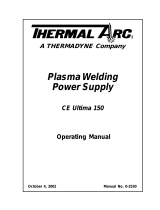 Thermal Arc Plasma Welding Power Supply Manuel utilisateur
Thermal Arc Plasma Welding Power Supply Manuel utilisateur
-
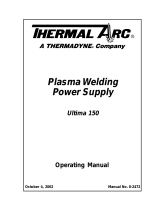 Thermal Arc Plasma Welding Power Supply Manuel utilisateur
Thermal Arc Plasma Welding Power Supply Manuel utilisateur
-
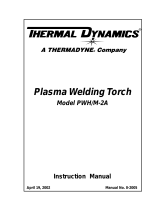 Thermal Dynamics Plasma Welding Torch Model PWH/M-2A Manuel utilisateur
Thermal Dynamics Plasma Welding Torch Model PWH/M-2A Manuel utilisateur
-
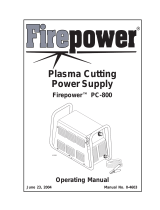 Firepower Plasma Cutting Power Supply Firepower™ PC-800 Manuel utilisateur
Firepower Plasma Cutting Power Supply Firepower™ PC-800 Manuel utilisateur
-
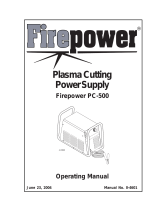 Firepower Plasma Cutting Power Supply Firepower PC-500 Manuel utilisateur
Firepower Plasma Cutting Power Supply Firepower PC-500 Manuel utilisateur
-
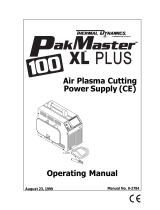 Thermal Dynamics PakMaster™ 100 XL™ Plus Air Plasma Cutting Power Supply Manuel utilisateur
Thermal Dynamics PakMaster™ 100 XL™ Plus Air Plasma Cutting Power Supply Manuel utilisateur
-
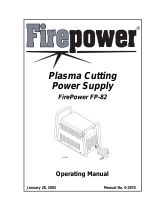 Firepower Plasma Cutting Power Supply Manuel utilisateur
Firepower Plasma Cutting Power Supply Manuel utilisateur
-
ESAB 1-3000-1 Le manuel du propriétaire
-
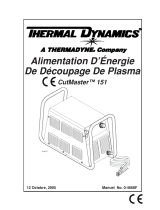 Thermal Dynamics CE CutMaster™ 151 Plasma Cutting Power Supply Manuel utilisateur
Thermal Dynamics CE CutMaster™ 151 Plasma Cutting Power Supply Manuel utilisateur
-
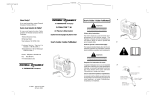 Thermal Dynamics CUTMASTER™ 38 Air Plasma Cutting System Guide de démarrage rapide
Thermal Dynamics CUTMASTER™ 38 Air Plasma Cutting System Guide de démarrage rapide

























































